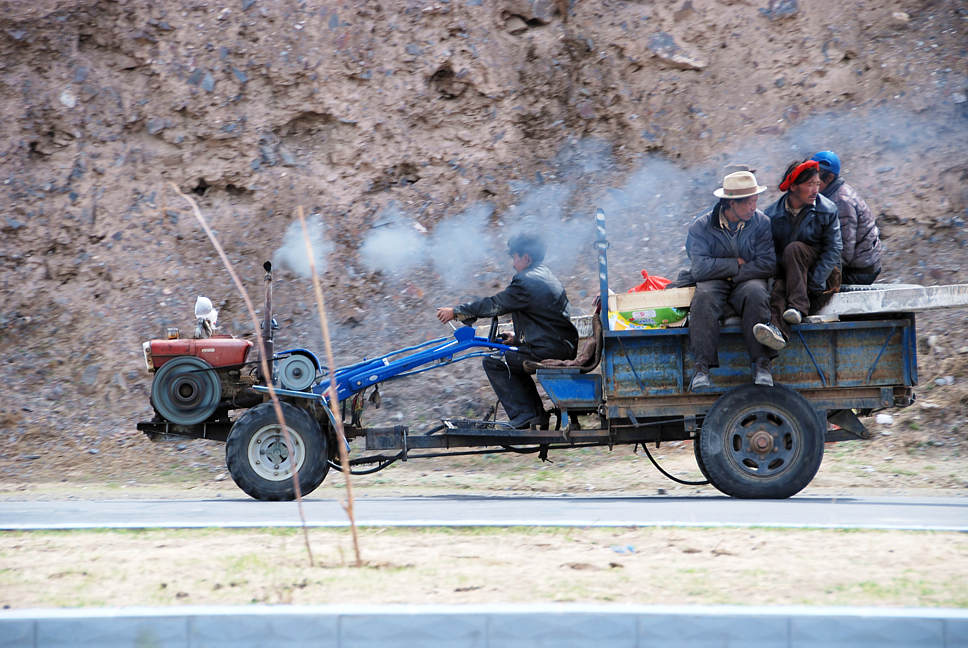Click here to jump to Mountain Lake Properties opening screen ... to Weather ..
.. Homes .. Land .. Commercial opportunities .. to Scenery .. to Bhutan.
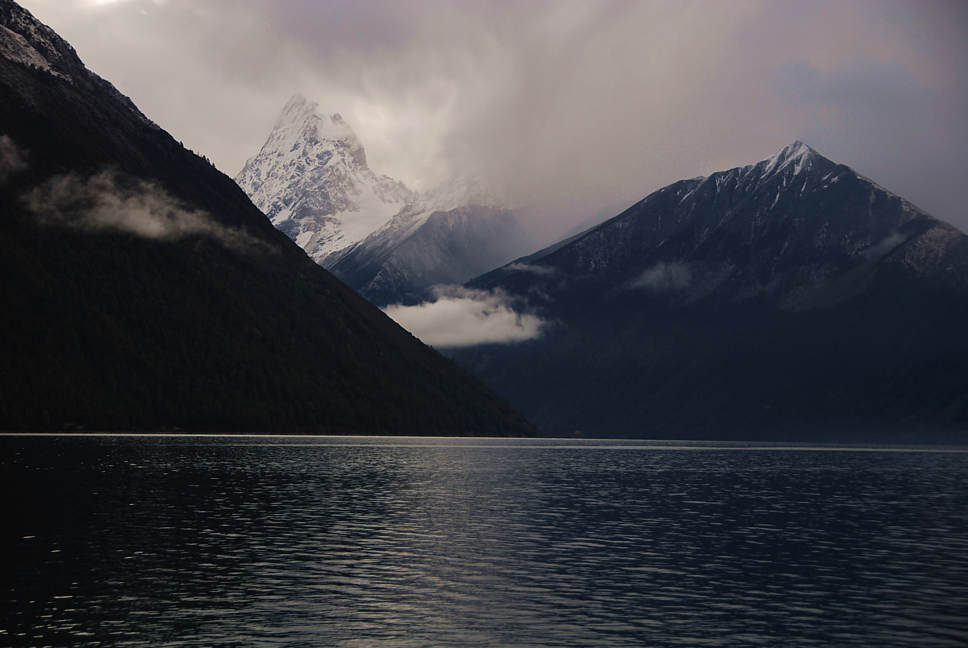
The summer monsoon brings a lot of rain here. The best mountain viewing
and climbing is in May. The Grand Lake environment is more kind to summer
visitors, with June offering dazzling clear skies, snowy peaks and long days for
enjoying everything. Thunderstorms do not become frequent until August.
Scroll down for more views. Click on a photo to return to the beginning
of this presentation. Later, we will fill in with a few more scenes from Tibet.
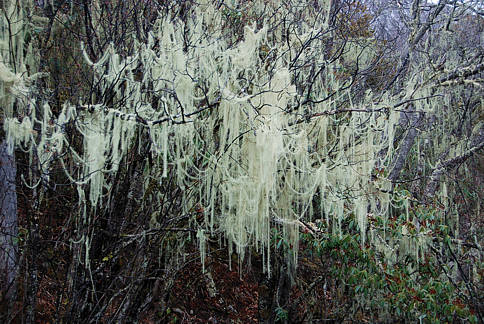
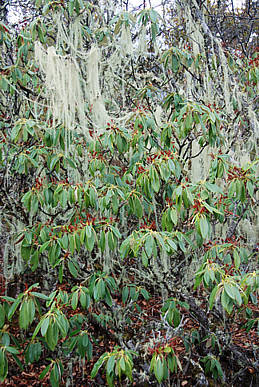

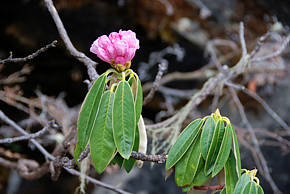
Whether you are in the Himalayas or in the Rockies, a sure sign of a healthy
forest is the presence of mosses hanging from the trees. They may look strange,
but they are not a sign of something dark or ominous (like pollution).
Hopefully,
the reader has not found our parallels between Draksum-tso and Grand Lake to be
forced. The curious parallels are a respectful play on the Buddhism we encountered
in Tibet. Look softly at the images above of the moss hanging like mist in the trees above.
Consider how it makes a forest look visionary. Consider how in miniature, it repeats
the larger pattern of snow up high, mist, and then verdant forest and flowers further down.
It's a simple exercise in similarities, yet something that runs through Buddhist history
and art as a thousand-and-one manifestations of more cosmic laws at work.
The images presented in these pages span a mere 18 hour period in Tibet. There is
much that we left out concerning our other days in Tibet and the logistics in getting around.
For most visitors to Tibet, the itinerary involves driving from one monastery to another,
or they go to the Everest Base camp area (which has a paved road now, right off the
Friendship Highway). We have tried to show something different. Concerning the Red Hat
sect Monastery at Draksum-sto, we left off some fascinating tidbits. Those monks are allowed
to marry and drink alcohol. An unexpected high point of our visit to their little island
monastery (kind of like Wizard Isle at Crater Lake in Oregon, but much warmer)
was a journey through a dark, low and hidden passageway. Upon emerging from it,
we were said to have absorbed some of the accumulated knowledge and wisdom
from the artifacts stored above it. Ahhh, if only studying for finals could be so easy...
In a few weeks, we will extend this presentation to show you more of Tibet.
For now, we will conclude with a few geopolitical remarks.
You can not get to eastern Tibet without being on a tour. A tour, however, can be just
your own family members as in our case, or whoever you want, unless one of the individuals is
already on a government list of those who are not permitted to be in Tibet. We created our own
itinerary and were exposed to a tremendous amount of Chinese, Tibetan and natural culture
in a remarkably short amount of time, while also not feeling rushed. Technically,
the trip would have been impossible to do years earlier or even recently due to
geopolitical barriers.
We landed in Beijing on Friday, April 3, after an almost 12 hour flight from San Francisco
into a headwind. To reduce the headwind, our flight path took us far north, over the Bering
Strait and over vast portions of Russian airspace that was not open to international flights
in the Cold War years. (On Sunday, April 5, a 3-stage rocket blasted off from North Korea
in a failed attempt to put a satellite into orbit; tensions over sharing air space remain.)
The same day we landed in Beijing, we boarded the new train that would comfortably take us
all the way across China to Lhasa, in Tibet, in 48 hours. The train actually arrived two hours early.
Along the route, we got to see quite a bit as to what makes China the powerhouse that it is.
Upon our arrival in Lhasa, we spent two days getting to know the city and then we made a three
day journey eastward into a verdant part of Tibet with snowcapped peaks towering over evergreen
forests, and valleys sewn with barley and colored with peach blossoms and richly painted homes.
Our arrival in Lhasa on April 5 happened to coincide with the first day the area had been open to
foreigners for a long time. Our permits and visa were in order and were checked and re-checked
many times with little delay or inconvenience. It is my understanding that the main purpose of these
checkpoints was to see if we matched anyone who had been blacklisted.
I am no expert on religions or geopolitics; nonetheless, I am going to give a quick summary here of
what I feel is the Tibet situation, as of April 14, 2009.
China is a powerhouse. It is not going to leave Tibet and no foreign country is going to change that.
I am not going to outline my reasons for these conclusions; I am just going to state them. The reader
may not like some or many of the things that Chinese politicians and engineers have done to their
country from Beijing to Lhasa and beyond. I understand these sentiments; nonetheless, I feel
that much of what has passed has been a matter of taste, and tastes change.
By that I mean that the Chinese themselves (and the original Tibetans) are going through changes
in taste. By taste, I mean the way buildings are built, the way rivers are managed, and the way
that foreigners and ethnic groups are treated. Tastes change and no one can dictate how they will
change, not from inside and not from outside.
Tastes are susceptible to being converted, especially from generation to generation. The exact
causes of these transformations in taste are complex. From country to country there are tales of
how tribes of people have been converted to Buddhism, or to Christianity or by Mao's cultural
revolution. The underlying causes of these revolutions and reprogrammings are not as simple
as they may seem on the surface.
When changes are forced and rushed, there can be many mistakes. When these changes are
spearheaded with indoctrination, it can take a long time to recognize and admit where mistakes
have been made. National pride can be a real bugaboo.
The history of Buddhism and its advance into Tibet is one of taming evil spirits. That's the Buddhist
version. It is not completely removed in technique and form from the advance of most any religion
or even Mao's cultural revolution. "History is written by the victors."
The Chinese presence in Tibet has grown so immense that there is no way that it can be untied
from Tibet's future. The Tibetans have even adopted Chinese tastes in their food. Twenty years
ago, meat and dairy products from yaks were primary sources of nutrition for Tibetans. Today,
the valley floors are filled with simple yet large greenhouses that produce fresh vegetables every
day of the year.
The same rails that brought us to Lhasa carry a prodigious amount of freight, soldiers and new settlers
to the region. This tide cannot be turned back; it already has and will continue to transform everything.
The real hope for Tibet is for the next generation of Chinese, Tibetans and itinerant travelers to have
a new sympathy, compassion and understanding of what is best for Tibet. Old habits fade slowly;
prejudices can linger for generations, although the pace of change is faster now than ever before.
The role of Buddhism is going to be as it has always been, to tame "evil spirits". This has been the
policy of the exiled Dalai Lama, although he frankly expressed his doubts about this strategy while
speaking publicly in India last month (March, 2009) to mark the 50th anniversary of his exile.
My uneducated feeling about this is that no outside country is going to make a difference on the China-
Tibet situation. The correction of mistakes will be performed from within by the current and next generations
of people elevating their tastes (in this already high region) in ways that are hidden, natural and inevitable.
Tibet is undergoing a process that is not unique to its region. If I were to give the process a name,
I wouldn't just call it evolution or learning. Maybe it has no name. When we do try to name it, we rush it.
The internal transformation cannot be improved by rushing it or forcing it. It spans lifetimes and is not
for the impatient.
For a region that believes in reincarnations and has its own peculiar geography and culture, is it unreasonable
to speak of the Tibetan region itself as undergoing deaths and rebirths? Could it be that Tibet is in the process
of manifesting itself anew? The time frame for the reincarnation of an entire country would be rather long
compared with human cycles, would it not? The phrasing of these questions is designed to give one a vantage
of the China-Tibet situation from a higher ledge, perhaps.
Before I went to Tibet, we had an inkling that there could be in eastern Tibet a lake that is in some respects
a "sister" lake to the largest natural lake in Colorado, our Grand Lake. Its "twin", of course could be in several
other places around the globe.
The laws of physics are independent of place and time, so aspects about mountains in the ways they are sloped,
hold snow and channel water and create mists can be repeated in geographically removed regions.
Furthermore, because people themselves are fundamentally equal, there can be eerie similarities in the way
distant regions are populated and developed.
There are abstract laws that shape the way things come into being. A physical manifestation is an "incarnation"
of these ideals. It should not be surprising for geographical features and even geopolitical aspects to be doubled,
tripled, in a word, reincarnated, even simultaneously. The Buddhist precepts concerning incarnation are usually
applied to people. Why not apply them to geophysical things where they make more sense? Could it be that that was
their original application? The appointment of political and religious leaders via reincarnation is a device to
honor transfers of power that is an improvement over the family line model that has haunted monarchies.
It is more democratic than trying to maintain a line of kings, but not as bold as the Jeffersonian model.
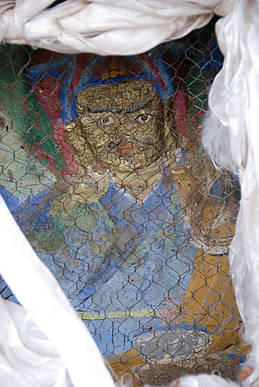
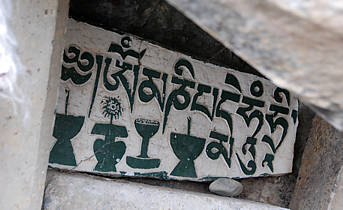
The small paintings above are almost hidden along the road that runs
part of the way along the south shore of Draksum-tso. They are in honor
of important figures in Buddhist history that resided at this storied lake
for repose and inspiration. More on this later.
Farewell and take care.
